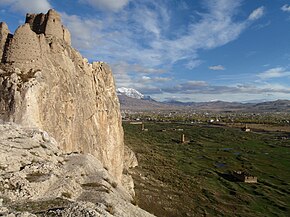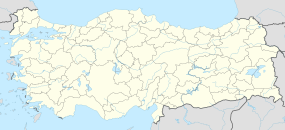Tushpa

The citadel of Van and the ruins of Tushpa below
|
|
| Location | Turkey |
|---|---|
| Region | Van Province |
| Coordinates | 38°29′59″N 43°20′30″E / 38.499667°N 43.341601°ECoordinates: 38°29′59″N 43°20′30″E / 38.499667°N 43.341601°E |
Tushpa (Armenian: Տոսպ Tosp, Assyrian: Turuspa, Turkish: Tuşpa) was the 9th-century BC capital of Urartu, later becoming known as Van which is derived from Biaina the native name of Urartu. The ancient ruins are located just west of Van and east of Lake Van in the Van Province of Turkey.
Archaeological excavations and surveys carried out in the Van Province indicate that the history of human settlement in this region dates back at least as far as 5000 BC. The Tilkitepe Mound located along the shores of Lake Van and a few kilometres to the south of the citadel of Van, is the only known source of information about the oldest cultures of Van predating the founding of Tushpa.
Tushpa was the capital of the Urartian kingdom in the 9th century BC. The early settlement was centered upon the steep-sided bluff now referred to as Van Fortress (Van Kalesi), not far from the shores of Lake Van and a few kilometers west of the modern city of Van.
The fortress of Van is a massive stone fortification built by the ancient kingdom of Urartu and held from the 9th to 7th centuries BC. It overlooks Tushpa, and is the largest example of this kind of complex. A number of similar fortifications were built throughout the Urartian kingdom, usually cut into hillsides and outcrops in places where modern-day Armenia, Turkey and Iran meet. Successive groups such as the Armenians, Romans, Medes, Achaemenid and Sassanid Persians, Arabs, Seljuqs, Ottomans and Russians each controlled the fortress at one time or another.
The lower parts of the walls of Van Citadel were constructed of unmortared basalt, while the rest was built from mud-bricks. Such fortresses were used for regional control, rather than as a defense against foreign armies. The ancient ruins of the fortress support walls constructed during the medieval era. Other cuneiform inscriptions have been found at the site and are typically off limits unless to large tour groups due to vandalism.
In the trilingual Behistun inscription, carved in the order of Darius the Great of Persia, the country referred to as Urartu in Babylonian is called Armenia in Old Persian.
...
Wikipedia

